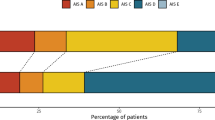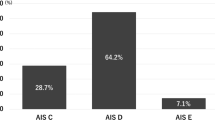Abstract
Study design:
Prospective multicenter longitudinal cohort study.
Objectives:
To determine the relationship between improvements of the American Spinal Injury Association/International Spinal Cord Society (ASIA/ISCoS) neurological standard scale (AIS) outcome measure and improvements of functional ambulatory outcome measures in patients with traumatic spinal cord injury (SCI).
Setting:
European multicenter study of human SCI (EM-SCI).
Methods:
In 273 eligible patients with traumatic SCI, acute (0–15 days) and chronic phase (6 or 12 months) AIS grades, timed up and go (TUG) test and 10-m walk test (10MWT) outcome measurements were analyzed. Subanalysis of those patients who did have AIS conversion was performed to assess its relation with functional ambulatory outcomes.
Results:
Studied population consisted of 161 acute phase AIS grade A patients; 37 grade B; 43 grade C and 32 acute phase AIS grade D patients. Forty-two patients (26%) converted from AIS grade A, 27 (73%) from grade B, 32 (75%) from grade C and five patients (16%) from AIS grade D. The frequencies of AIS conversions and functional ambulation recovery outcomes were significantly different (P<0.001) in patients with motor complete SCI. The ratio of patients with both recovery of ambulatory function and AIS conversion (n=101) differed significantly (P<0.001) between the acute phase AIS grade scores; AIS grade A (6/40 patients, 15%), B (9/27 patients, 33%), C (23/29 patients, 79%) and D (5/5 patients 100%).
Conclusions:
The AIS conversion outcome measure is poorly related to the ability to walk in traumatic SCI patients. Therefore, the authors recommend the use of functional ambulation recovery outcome measures in prognosticating the recovery of walking capacity and performance of patients with SCI.
Similar content being viewed by others
Log in or create a free account to read this content
Gain free access to this article, as well as selected content from this journal and more on nature.com
or
References
Ditunno PL, Patrick M, Stineman M, Ditunno JF . Who wants to walk? Preferences for recovery after SCI: a longitudinal and cross-sectional study. Spinal Cord 2008; 46: 500–506.
Lam T, Noonan VK, Eng JJ . A systematic review of functional ambulation outcome measures in spinal cord injury. Spinal Cord 2008; 46: 246–254.
Steeves JD, Lammertse D, Curt A, Fawcett JW, Tuszynski MH, Ditunno JF et al. Guidelines for the conduct of clinical trials for spinal cord injury (SCI) as developed by the ICCP panel: clinical trial outcome measures. Spinal Cord 2007; 45: 206–221.
American Spinal Unjury Association. International Standards for Neurological Classification of Spinal Cord Injury, revised 2002. American Spinal Injury Association: Chicago, IL, 2002.
Geisler FH, Coleman WP, Grieco G, Poonian D . The Sygen multicenter acute spinal cord injury study. Spine 2001; 26 (24 Suppl): S87–S98.
Kirshblum S, Millis S, McKinley W, Tulsky D . Late neurologic recovery after traumatic spinal cord injury. Arch Phys Med Rehabil 2004; 85: 1811–1817.
Marino RJ, Ditunno Jr JF, Donovan WH, Maynard Jr F . Neurologic recovery after traumatic spinal cord injury: data from the Model Spinal Cord Injury Systems. Arch Phys Med Rehabil 1999; 80: 1391–1396.
McKinley W, Meade MA, Kirshblum S, Barnard B . Outcomes of early surgical management versus late or no surgical intervention after acute spinal cord injury. Arch Phys Med Rehabil 2004; 85: 1818–1825.
Podsiadlo D, Richardson S . The timed ‘Up & Go’: a test of basic functional mobility for frail elderly persons. J Am Geriatr Soc 1991; 39: 142–148.
Salbach NM, Mayo NE, Higgins J, Ahmed S, Finch LE, Richards CL . Responsiveness and predictability of gait speed and other disability measures in acute stroke. Arch Phys Med Rehabil 2001; 82: 1204–1212.
van Hedel HJ, Wirz M, Dietz V . Assessing walking ability in subjects with spinal cord injury: validity and reliability of 3 walking tests. Arch Phys Med Rehabil 2005; 86: 190–196.
Keith RA, Granger CV, Hamilton BB, Sherwin FS . The functional independence measure: a new tool for rehabilitation. Adv Clin Rehabil 1987; 1: 6–18.
Dittuno PL, Dittuno Jr JF . Walking index for spinal cord injury (WISCI II): scale revision. Spinal Cord 2001; 39: 654–656.
Morganti B, Scivoletto G, Ditunno P, Ditunno JF, Molinari M . Walking index for spinal cord injury (WISCI): criterion validation. Spinal Cord 2005; 43: 27–33.
Kirshblum SC, O’Connor KC . Predicting neurologic recovery in traumatic cervical spinal cord injury. Arch Phys Med Rehabil 1998; 79: 1456–1466.
Scivoletto G, Di Donna V . Prediction of walking recovery after spinal cord injury. Brain Res Bull 2008 (e-pub ahead of print 16 July 2008).
American Spinal Injury Association. Standards for Neurological Classification of SCI Worksheet, Revised 2006. Available at URL: http://www.asia-spinalinjury.org/publications/2006_Classif_worksheet.pdf (accessed on August 2008).
van Hedel HJ, Wirz M, Dietz V . Standardized assessment of walking capacity after spinal cord injury: the European network approach. Neurol Res 2008; 30: 61–73.
Jaeger R, Brechtel K, Schluesener HJ, Conrad S, Kaps HP, Schwab JM . A simple methodology to improve AIS-based assessment of recovery after acute spinal cord injury. Spinal Cord 2005; 43: 61–63.
Graves DE, Marino RJ . Metric properties of the International Standards for Neurological Classification of Spinal Cord Injury, implications for research use. In: Neurological Standards Committee of the American Spinal Injury Association (ed). Reference manual for the International Standards for Neurological Classification of Spinal Cord Injury. American Spinal Injury Association: Chicago IL, 2003, pp 68–88.
Marino RJ, Graves DE . Metric properties of the ASIA motor score: subscales improve correlation with functional activities. Arch Phys Med Rehabil 2004; 85: 1804–1810.
Ditunno Jr JF, Barbeau H, Dobkin BH, Elashoff R, Harkema S, Marino RJ et al. Validity of the walking scale for spinal cord injury and other domains of function in a multicenter clinical trial. Neurorehabil Neural Repair 2007; 21: 539–550.
Wirz M, van Hedel HJ, Rupp R, Curt A, Dietz V . Muscle force and gait performance: relationships after spinal cord injury. Arch Phys Med Rehabil 2006; 87: 1218–1222.
Ishida Y, Tominaga T . Predictors of neurologic recovery in acute central cervical cord injury with only upper extremity impairment. Spine 2002; 27: 1652–1658;(discussion 8).
Thongtrangan I, Le H, Park J, Kim DH . Cauda equina syndrome in patients with low lumbar fractures. Neurosurg Focus 2004; 16: e6.
Blaustein DM, Zafonte R, Thomas D, Herbison GJ, Ditunno JF . Predicting recovery of motor complete quadriplegic patients. 24 v 72 h motor index scores. Am J Phys Med Rehabil 1993; 72: 306–311.
Brown PJ, Marino RJ, Herbison GJ, Ditunno Jr JF . The 72-h examination as a predictor of recovery in motor complete quadriplegia. Arch Phys Med Rehabil 1991; 72: 546–548.
Acknowledgements
This study was supported by ‘Acute Zorgregio Oost’ and the ‘Internationale Stiftung für Forschung in Paraplegie’ (IFP). We thank all the members of the European Multicenter Study of Human Spinal Cord Injury (EM-SCI), especially Mrs Henny Janssen and Christian Schuld for their assistance in data collection and data processing.
Author information
Authors and Affiliations
Consortia
Corresponding author
Rights and permissions
About this article
Cite this article
van Middendorp, J., Hosman, A., Pouw, M. et al. ASIA impairment scale conversion in traumatic SCI: is it related with the ability to walk? A descriptive comparison with functional ambulation outcome measures in 273 patients. Spinal Cord 47, 555–560 (2009). https://doi.org/10.1038/sc.2008.162
Received:
Revised:
Accepted:
Published:
Issue date:
DOI: https://doi.org/10.1038/sc.2008.162
Keywords
This article is cited by
-
Classification of upper-limb dysfunction severity and prediction of independence in activities of daily living after cervical spinal-cord injury
Spinal Cord (2024)
-
Priming locomotor training with transspinal stimulation in people with spinal cord injury: study protocol of a randomized clinical trial
Trials (2023)
-
Interrater reliability of the Standing and Walking Assessment Tool for spinal cord injury
Spinal Cord (2023)
-
Orthotic walking outcome of persons with motor complete low thoracic spinal cord injury—a retrospective study
Spinal Cord (2023)
-
Daily acute intermittent hypoxia to improve walking function in persons with subacute spinal cord injury: a randomized clinical trial study protocol
BMC Neurology (2020)



